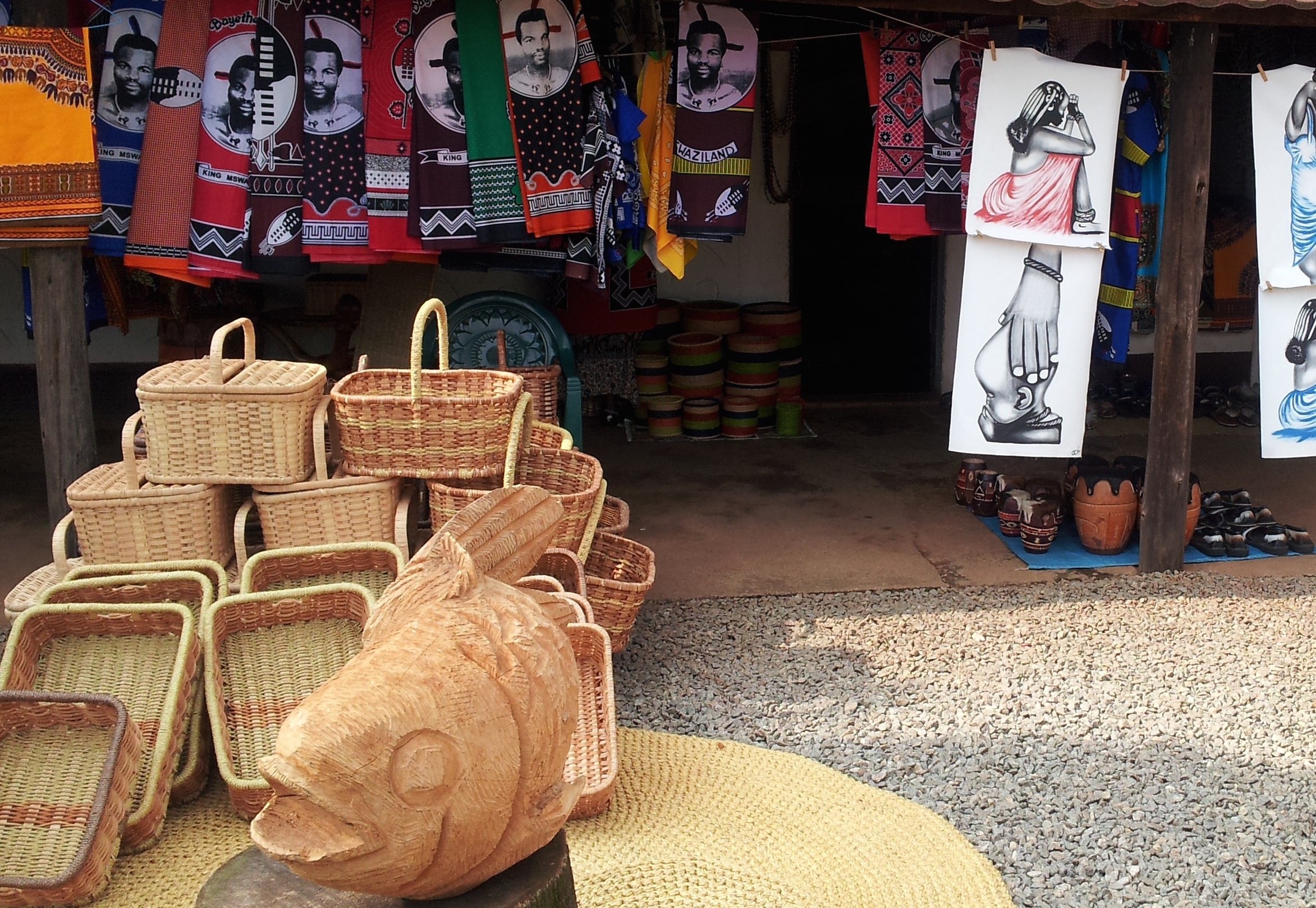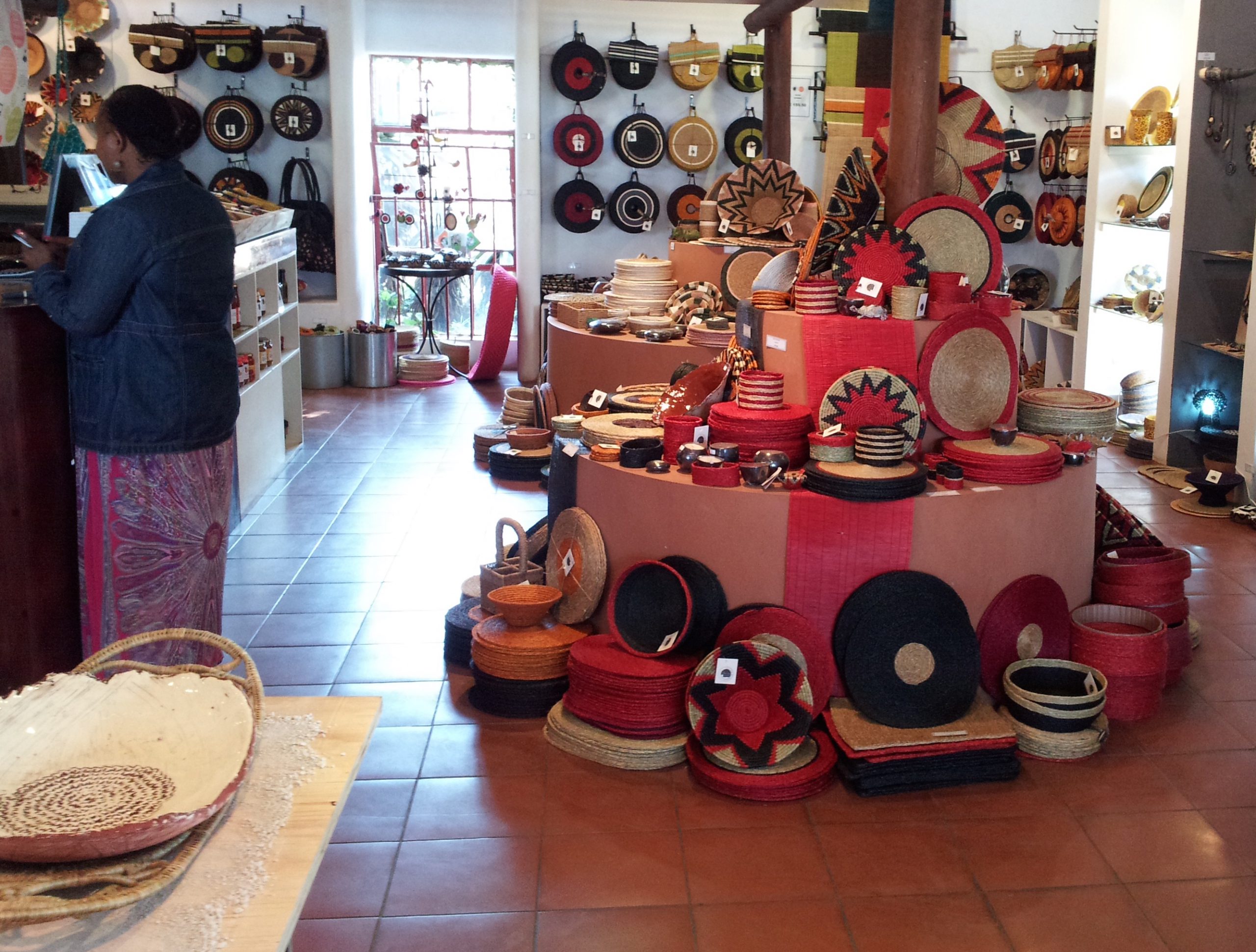Dreamy acrylic landscapes splashed on cloth canvases and boldly printed tablecloths hang on the walls and across the doorway, tinting the already dim shack’s interior a curious shade of amber. Around the small stall’s narrow corridor, all the surfaces and every square inch of floor space are crammed with a kaleidoscopic collection of crafts: decorative utensils and bowls, metal and beaded jewelry, polished wooden wildlife in miniature.
Just outside the doorway, perched on an artfully crafted wooden footstool beside an arrangement of multicolored woven grass baskets of varying sizes, sits a stout, middle-aged woman. She has individually crafted each item with her rough hands—sometimes with the help of her family or other women in her community—over the span of anywhere from a few days to several weeks. She is the owner of the stall and everything within it, and she passes her afternoons selling her creations to the intermittent flow of local buyers and international tourists.
This scene is common near hotels and popular tourist destinations, as well as on roadsides and in the bustling open-air markets of Swaziland’s most populous cities. The country has a long and robust tradition of combining artistic and utilitarian crafts. It is not difficult to find members of society who have knowledge, skill, or experience in some form of craft.
A convenient mix of local circumstances makes handicraft an appealing venture for those with limited means: many of the raw materials used to create the craft pieces can be acquired at little or no cost from the local environment, and free or cheap labor is available in the form of kin and community members. However, in spite of these encouraging conditions, handicraft remains a fairly unpopular career path.
However, this profession has matured significantly throughout Swazliand in recent years. It is gaining prominence both economically, as a blossoming industry with a place in national and international markets, and socially, as a promising tool for grass-roots poverty alleviation. In spite of this seeming success, though, there are still many challenges ahead for the practitioners, policy-makers, and private entities who are striving to legitimate the industry while carving out a lasting place for an ancient tradition in the modern world.
Local Going Global
Zinhle Vilakati smiles broadly, her fine wrinkles exaggerated by the late afternoon sunlight, as she recounts how she ended up in her current line of work. Vilakati has been working for eight years with Gone Rural, a non-governmental organization that strives to help female artisans from across the country earn a fair wage and make a sustainable living from their craft. She initially joined as one of the artisans, working primarily in weaving grass products, and is now the head of product development.
Her story is rather atypical: unlike most of the women who are driven by lack of options to pursue handicraft as their livelihood, Vilakati has completed post-secondary education and has a degree in business administration. For her, handicraft was a choice, not a last resort. “My mother used to work in handicraft. I saw how she was able to provide for the family and I decided I wanted to pursue the trade, too,” Vilakati told the HPR. “I enjoy the work; it is flexible and gives me a way to stay connected to my heritage and help spread Swazi culture to people overseas.”
The majority of those who enter the craft sector do so with more immediate motivations. Although there are a few notable exceptions in the high-end design sector, handicraft is predominantly seen as an occupation of last resort: it tends to attract those who, due to their circumstances, have difficulty making a living through other means—namely rural women who were unable to complete secondary school. Many of these women pursue the practice out of necessity. Others use it as a secondary source of income to supplement meager earnings from subsistence farming or another low-paying primary occupation (usually a part-time position as a child-minder or cleaner).
The government and NGOs have taken notice. There are currently several public initiatives in place, primarily directed toward formalizing and improving the existing bedrock of indigenous skill and practical knowledge. The cornerstone of these efforts is the National Handicraft Training Centre (NHTC), where Zodwa Pato has worked for 27 years, first as a teacher then as principal. She explained to the HPR that the Centre offers classes in a variety of vocations and skills, but added that aspiring artisans continue to face challenges. “We try to give our students the tools to gain self-sufficiency, but there are still many problems,” she added.
The center’s aims are still more aspirational than concrete. Despite its attempts to expose students to trade fairs, exhibitions, competitions, and other gateways to larger markets, many of their graduates fail to persist in the profession. Most either decide to make their living in another field with a potential for better income and employment security or join Swaziland’s sizable civil service. “There is some stigma around crafts,” Pato said. “People don’t take it seriously; it is usually seen as an avenue for the uneducated and not as a reasonable career option even though it can become a well-paying job in both the local and export markets. We are trying hard to change this belief and show people that it is a useful trade and valid profession that needs to be encouraged.”
The public sector is not alone in its push to capitalize on the economic and social possibilities that handicraft presents. Many NGOs also focus on using handicraft as an avenue to alleviate poverty by empowering those who would otherwise end up as society’s bottom rung. Gone Rural is one such organization. So is Swaziland Fair Trade (SWIFT), an organization that aims to raise the quality of local crafts and connect local artisans to international markets for their products.
Doron Shantile, founding member of SWIFT and owner of the urban handicraft project Quasi Design, explained the motivations of the organization’s founders, a collection of artisans who grew the organization through trade shows. “A group of us wanted to create a platform to share best practices; I personally loved the combination of business, handicraft and all the opportunities for job creation,” she told the HPR. “Our focus was on helping artisans make a living wage through full-time work.” SWIFT strives to help artisans develop the knowledge and skills to be able to function in the global marketplace. With the intervention of groups like these, handicraft is becoming a more stable and low-risk venture option for entrepreneurs as well as a dependable source of income for otherwise economically vulnerable women.
Falling Behind
Despite all the progress, the situation is still far from idyllic for those, like Gabriel Makuku, who fall through the current framework’s cracks. As an immigrant artisan from Mozambique, he benefits from neither state interventions nor existing non-governmental programs. For Makuku, making a living off his metal crafts is as difficult now as it has ever been. He followed his father across the border and into the trade almost three decades ago and has dedicated his entire working life to metal craft, but now he sees no future in it.
Makuku’s products are distinctly utilitarian—rain water collection tanks, crude traditional medical equipment, poultry feed buckets. Since his products are primarily for agricultural use, he operates in the countryside, where demand is dictated by weather, whim, and small-scale economic fluctuations. There is no place for his wares outside of the fickle local market where the unfortunate location compounds his commercial limitations. “Business is hard,” Makuku told the HPR, his face drawn, years of hardship reflected in the deep, persistent furrow of his brow and the tired slope of his shoulders. “I work together with all my [four] brothers, but it is still slow. … It is difficult to support the family back home. I think I want to leave this business now but I don’t know.”
His uncertainty reflects the risk and difficulty inherent in operating a handicraft business outside the insulated economic ecosystem created by targeted government policies and dedicated non-profit organizations. For artisans in programs like Gone Rural, the NHTC, or SWIFT, handicraft promises a potential avenue out of poverty. But for those like Makuku, whose products lack international appeal and have no place in this budding economic revolution, handicraft remains a trade of last resort.
Image credit: Jessica Sithebe

